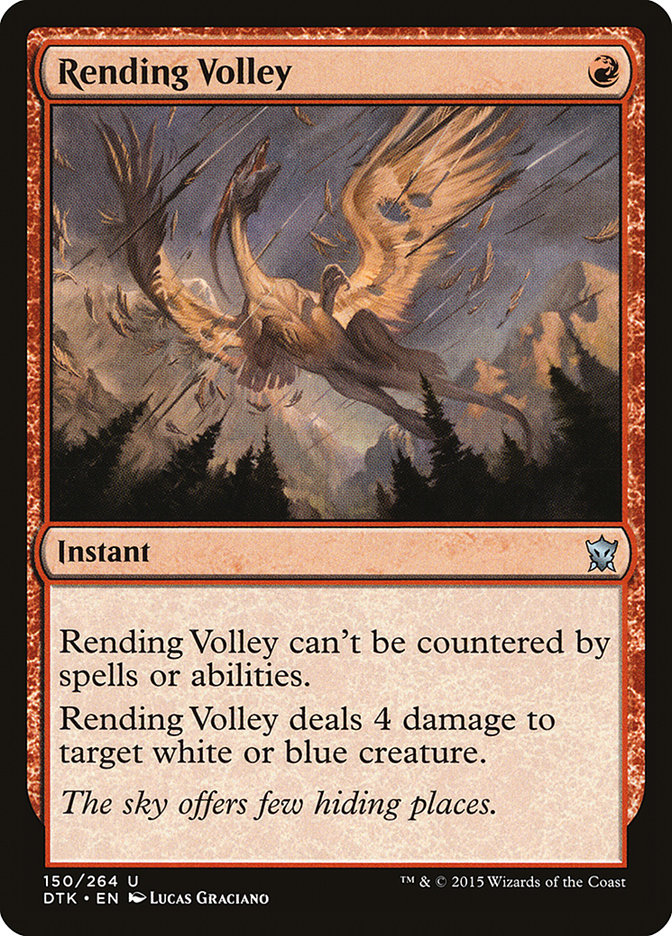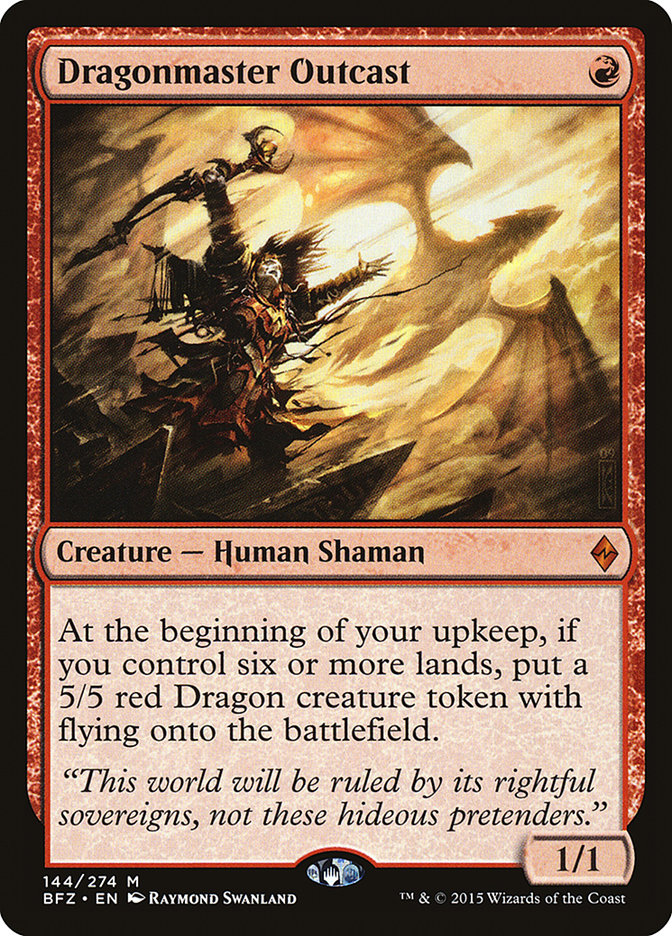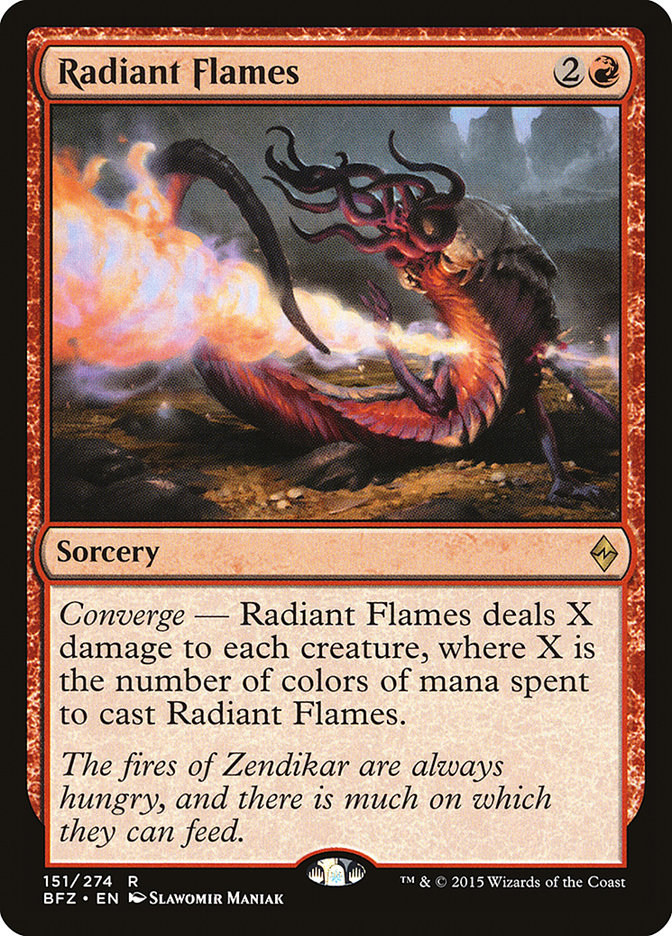In case you haven’t been playing attention, G/W Megamorph has been running roughshod over Standard since the release of Battle for Zendikar. It began with Michael Majors’s runner-up finish at #SCGINDY and continued last weekend at #SCGATL with four copies of the deck in the Top Eight, with a mirror match in the finals.
For me, G/W Megamorph is far and away the best deck in Standard currently. I know there are other powerful options like Jeskai Black, Esper Dragons, and various shades of Abzan, but none of them are able to do what G/W Megamorph can do in regards to being good at all stages of the game.
You’ll note that I used the word currently in the sentence “For me, G/W Megamorph is far and away the best deck in Standard currently.” The reason for that is because I think people expect that to change after the Pro Tour. Most are looking at the results of #SCGINDY and #SCGATL and are expecting them to be irrelevant after the Pro Tour is complete.
I’m not. I expect G/W Megamorph to be the best deck walking into the Pro Tour, and I expect it to be the best deck walking out of the Pro Tour. Why am I so confident about this? For many reasons actually, so let’s go over the strengths of the deck:
Strengths
1) This is the only deck that is good at all stages of the game.
This is a point that Patrick and I have certainly driven home during coverage of #SCGINDY and #SCGATL, but watching the deck play demonstrates this very effectively. Being able to get off to an aggressive start with Warden of the First Tree, Hangarback Walker, and Deathmist Raptor is great in matchups that look to go over the top of you like Esper Dragons and any Eldrazi deck that people are playing. Those decks are looking to play a longer game so they can dominate with their expensive cards (Ugin, the Spirit Dragon; Ulamog, the Ceaseless Hunger), but G/W Megamorph is capable of pressuring them in such a fashion that it isn’t realistic to cast those cards in time.
When you work your way into a midrange battle against a deck like Abzan and Jeskai, G/W Midrange is rather comfortable as well. Den Protector and Wingmate Roc are midrange trumps that people were going to pre-rotation and are happy to go to yet again. The fact that both of these cards fit so naturally into G/W Megamorph is almost scary because they’re so powerful when games start to get messy. Toss in Gideon, Ally of Zendikar and all of a sudden you don’t really care if Siege Rhino shows up to the table all that much.
But what really sold me on this deck is the ability to win a game that has gone on longer than eight turns. Being able to pressure a control deck is nice, but being able to go toe-to-toe with them in the late game, and arguably do more powerful things than them in a late game, is very unusual for a G/W deck. But that’s exactly what G/W Megamorph is able to do thanks to the Den Protector/Deathmist Raptor combo, Hangarback Walker being a hassle to deal with, and Nissa, Vastwood Seer being a must-answer threat. And that doesn’t even begin to mention the hell that it is for control decks to try and overcome Evolutionary Leap and/or Mastery of the Unseen.
Whether you’re playing against an aggressive deck like Atarka Red, something midrange-y like Abzan or Jeskai, or going long against blue-based control, you have tools at your disposal to beat all three types of deck and none of them are huge stretches to play.
2) Your mana is very good.
Take a look at this manabase from Michael Majors’s runner-up finish as well as Jacob Lively’s win:
Creatures (24)
- 3 Wingmate Roc
- 4 Warden of the First Tree
- 2 Hidden Dragonslayer
- 4 Den Protector
- 4 Deathmist Raptor
- 3 Nissa, Vastwood Seer
- 4 Hangarback Walker
Planeswalkers (4)
Lands (15)
Spells (17)

Creatures (24)
- 3 Wingmate Roc
- 4 Warden of the First Tree
- 2 Hidden Dragonslayer
- 4 Den Protector
- 4 Deathmist Raptor
- 3 Nissa, Vastwood Seer
- 4 Hangarback Walker
Planeswalkers (4)
Lands (14)
Spells (18)

We have a few things worth nothing here:
- A lot of basic lands. In this format full of tri-lands, Battle lands, fetchlands, painlands, and creature-lands, basic lands are the most #basic thing I’ve ever seen. And yet they might also be the most powerful because having lands consistently enter the battlefield untapped is not to be overlooked. We have seen time and time again where decks are looking to do incredibly powerful things but their mana simply doesn’t cooperate, and those losses add up over time. It’s easy to say “Eh, I got unlucky. It happens.” But when you register a deck that is trying to play Mantis Rider and Crackling Doom, you’re also registering a few losses to mana issues as well.
- 25 lands (and it should probably be 26). G/W Megamorph is a mana-hungry deck, so playing a lot of lands isn’t a bad thing. But if you’re going to play a lot of lands you’d better have a lot to do with the mana, and this deck has plenty. Between un-megamorphing Den Protector/Deathmist Raptor/Hidden Dragonslayer, activating Warden of the First Tree and Hangarback Walker, flipping Nissa, Vastwood Seer, and abusing Evolutionary Leap and Mastery of the Unseen during sideboard games, this deck wants a lot of lands. A deck like Jeskai Black needs to play a lot of lands just to make its mana work, but once it starts drawing a lot of lands it doesn’t have very much to do with them. For G/W Megamorph it’s the direct opposite, and that’s an aspect I like about the deck quite a bit.
- Less brainpower being used. You may laugh at that being a benefit of a deck, but in this case I think it’s absolutely worth pointing out. Magic, as you may know, is a very complicated game. We, as human beings, only have so much brainpower to be used, and right now a lot of it is being used on trying to figure out how to search out mana with fetchlands and Battle lands. I’ve watched some of the best players on the Open Series over the past two weekends struggle with how to sequence their lands in the first few turns of the game, and then tell me that they got it wrong even though the spent a large amount of time trying to figure it out. I’ve always been a big fan of trying to keep things as simple as possible when playing Magic, and G/W Megamorph gets to do that with their manabase. You’ve got a bunch of basics, some fetchlands to find Canopy Vista, and… that’s it! Which is good! Because I’d rather focus on how to annihilate my opponent with this Dromoka’s Command instead of trying to be work my way through the corn maze that is fetchlands + Battle lands.
3) The power level of the deck is through the roof.
When the entire spoiler of Battle for Zendikar was released, many looked at all the possibilities. “I can play Siege Rhino side-by-side with Mantis Rider and Crackling Doom!” many said. And while that is certainly a possibility, that doesn’t mean it’s even that powerful. It’s just an option that is available. Coming into this new Standard format, if someone told me that a two-color deck would be the best deck, I would assume that said two-color deck sacrificed power level for consistency and good mana.
Where, exactly, is the sacrifice in power level here?
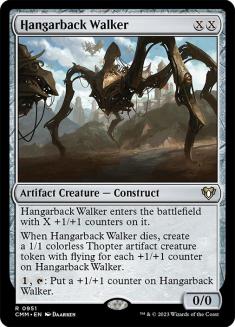
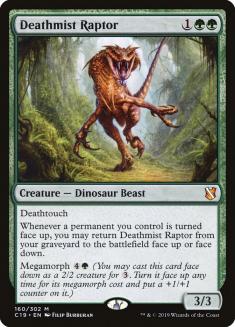
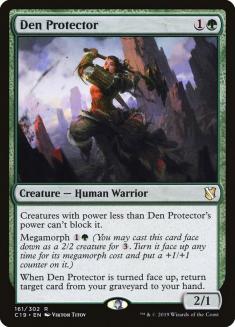
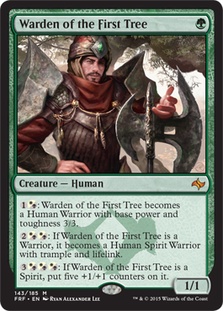
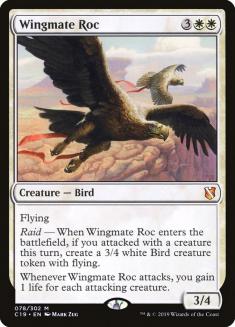
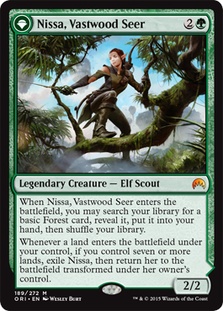
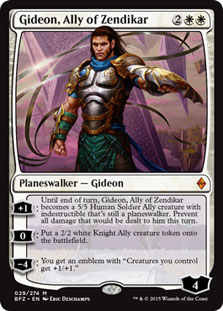
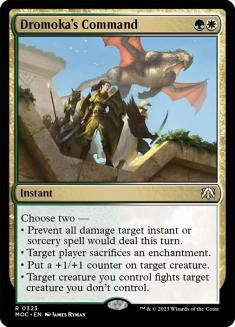
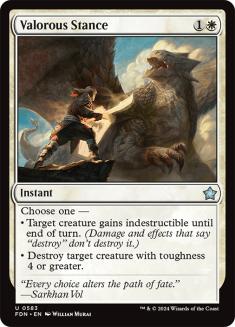
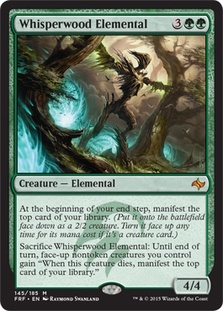
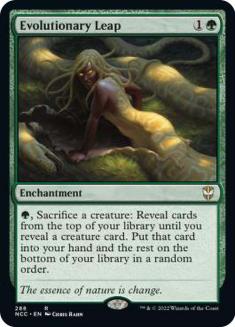
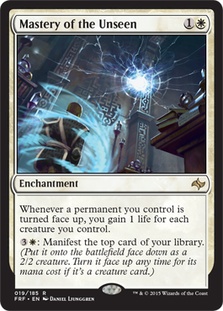
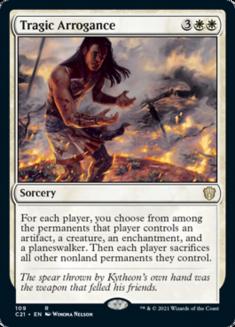
Because something has to be the “worst” card, I would give that award to Hidden Dragonslayer, a card that is really good against Atarka Red, un-megamorphs to kill Siege Rhino, and returns Deathmist Raptor.
Woe. Is. Me.
4) Splashing a third color is very easy to do.
As we saw at #SCGATL via Tom Ross, splashing a third color is very easy to do:
Creatures (24)
- 2 Wingmate Roc
- 4 Warden of the First Tree
- 1 Stratus Dancer
- 2 Hidden Dragonslayer
- 4 Den Protector
- 4 Deathmist Raptor
- 3 Nissa, Vastwood Seer
- 4 Hangarback Walker
Planeswalkers (3)
Lands (25)
Spells (8)

So how good is the blue splash? I think it does a fantastic job of solidifying the non-G/W Megamorph matchup, which is certainly a nice option to have. But given that I believe G/W Megamorph is the best deck, I think the time for this blue splash isn’t right now. If the format does start to become a bit more spread out, blue cards like Dispel, Stratus Dancer, Disdainful Stroke, and potentially Sagu Mauler are a great spot to be in. But given the dominance of G/W Megamorph thus far, I think you want to adjust the deck to get a leg up in the mirror (and I’ll tell you how to do that soon enough).
My larger point is that splashing a third color is comically easy. You’ve already got fetchlands, so playing a Prairie Stream is trivial. Lumbering Falls is close to a freebie, but keep in mind that a huge selling point of G/W Megamorph is having lands that enter the battlefield untapped. So do the positives of having Lumbering Falls (an additional creature that is hard to kill, mana fixing though it is slow) outweigh the negatives (having an additional land that enters the battlefield tapped, having a land that doesn’t play well with the basic lands + Battle lands manabase)? That’s hard to tell from just one tournament, but I’m leaning towards no because a hard-to-kill 3/3 doesn’t move the needle for me much (though making it a 4/4 with a Gideon emblem is somewhat attractive to me).
Now, even though I like this deck a lot there certainly are some negatives, so let’s discuss those.
Negatives
1) You’re weak to fliers.
Cards like Mantis Rider, Dragonlord Ojutai, and Thopter tokens from Hangarback Walker are a real pain to deal with. You do have access to answers like Silkwrap, Dromoka’s Command, and your own Thopters from your own Hangarback Walkers, but flying has always been a weakness for G/W decks and G/W Megamorph is no different. That said, you do have plenty of options to work yourself out of trouble like the versatile removal spells mentioned earlier, or more narrow options like Plummet.
2) Jace, Vryn’s Prodigy is very hard to kill.
So this is an interesting card to list in the negatives. The reason I say that is because I have watched a lot of games where Jace has been cast on turn two, has been activated numerous times, flips, recasts a spell from the graveyard, and the Jace player hasn’t gotten close to winning. Is that an Anna Molly? I’m not sure. Jace naturally promotes a longer game, and as I explained earlier, G/W Megamorph doesn’t mind playing a longer game… and in some matchups that involve Jace, I believe it wants to play a longer game. With all that said, Jace is likely still a must-answer threat, and you don’t have a ton of ways to do as much (Silkwrap and Dromoka’s Command mostly).
3) The mirror feels like a crapshoot.
Watching the finals of #SCGATL, Patrick and I expected a long, drawn-out affair, but it was actually one of the shorter matches that we had on the weekend. That leads me to believe that the mirror isn’t horribly skill intensive. Now I’m not saying there aren’t decisions to be made, because there certainly are (just like in every matchup in Magic), but if those games were any indication then getting a leg up in the mirror might be about who gets off to a faster start or who draws more copies of Dromoka’s Command.
4) Atarka Red is scary to play against.
Before the finals of #SCGINDY began, Patrick and I expected Majors to dismantle DeMars in every stage of the game, but that wasn’t even close to what happened. DeMars showed that trying to block against his deck was a useless exercise and went on to beat Majors very quickly on his way to the title. Given that G/W Megamorph is essentially all creatures, and that its best spell, Dromoka’s Command, requires a creature to be on the battlefield in order to be optimal, something needs to be changed to fix the matchup. Players have begun adopting Surge of Righteousness and Silkwrap as a way to interact early, and I like that a whole lot better than Arashin Cleric because LOL BLOCKING.
Where To Go From Here
If I was playing in the Pro Tour or SCG States this weekend, I would play something very close to the following:
Creatures (24)
- 3 Wingmate Roc
- 4 Warden of the First Tree
- 2 Hidden Dragonslayer
- 4 Den Protector
- 4 Deathmist Raptor
- 3 Nissa, Vastwood Seer
- 4 Hangarback Walker
Planeswalkers (4)
Lands (25)
Spells (7)

Things worth nothing:
- The maindeck is boring and basically the same. Basically, if it isn’t broke, don’t fix it. This maindeck just works right now, and I don’t see much of a reason to change it. I can see an argument for scaling back a bit on Dromoka’s Command, Gideon, Ally of Zendikar, or Hangarback Walker to maybe fit in a copy or two of Valorous Stance, but I like this setup a lot and Valorous Stance appears to be getting worse and worse as days go by.
- Splashing red is laughably easy. Much like Tom Ross’s splash of blue in Bant Megamorph, splashing red is incredibly easy in Naya Megamorph. You don’t get access to a creature-land like Lumbering Falls, but I was never a big fan of Lumbering Falls to begin with. Best of all, you still get to play a ton of basics, which means a lot of your lands are entering the battlefield untapped.
- The red splash seems absolutely fantastic right now. This deserves a lot more than a single bulletpoint, so let’s go over each of these red cards:
First up is Rending Volley. As mentioned earlier when going over Megamorph’s weaknesses, Mantis Rider, Dragonlord Ojutai, and Jace, Vryn’s Prodigy are all problems for this deck. Fortunately Rending Volley is a one-mana answer that solves all three and happens to be uncounterable (which will come up with Ojutai because of Silumgar’s Scorn and Dispel). The ability to kill all of these creatures with such ease is incredible, as is the ability to return Rending Volley with Den Protector so efficiently. In Magic, the Eternal Witness-type effects are best with cheap spells (think actual Eternal Witness, Snapcaster Mage, Jace, Telepath Unbound, etc) and Rending Volley is a cheap as it comes while having a huge impact on the game and being an answer for some of your largest problems.
Next up is Dragonmaster Outcast. If you’ve seen Jeskai Black in action, it is a deck that is centered around Jace, Mantis Rider, and Ojutai’s Command. But now it is very quickly being built around casting Ojutai’s Command to return Dragonmaster Outcast to pump out a Dragon and win the game. And if it ever gets to pump out a second Dragon, it’s lights out (guerilla radio). This has been the way that these Jeskai decks have beaten G/W Megamorph, and naturally that makes sense. It’s a cheap threat that is hard to answer that has a huge impact on the game (much like Jace), comes back with Ojutai’s Command (much like Jace), and creates fliers (which are already a problem). The difference between Dragonmaster Outcast and things like Jace and Mantis Rider is that it ends the game very quickly.
So why am I splashing almost exclusively for the card? Because I’ve got some interest in breaking open the mirror and this is likely a great way to do it. Now keep in mind that part of the reason that Dragonmaster Outcast is fantastic in Jeskai is because of how well it interacts with Ojutai’s Command. You can discard Outcast early in the game to Jace and rebuy it with Command. If the opponent kills the Outcast, you can rebuy it with Command like almost nothing happened. And while Naya Megamorph cannot duplicate that power, being able to return it via Den Protector or blow up a Silkwrap or Stasis Snare that took care of it with Dromoka’s Command is a fairly close replication. The goal is to be able to keep presenting Dragonmaster Outcast as a threat until your opponent cannot beat it, and Naya Megamorph can do that fairly well.
Last up is Radiant Flames. This one is fairly simple – I don’t want to lose to Atarka Red. While Surge of Righteousness, Arashin Cleric, and Silkwrap are fine cards against Atarka Red, I want the Pyroclasm effect more than anything against them, as there isn’t a lot they can do about it. As we’ve seen, cards like Languish and other sweepers are too slow against Atakra Red, so if you’re going to have a sweeper against Atarka Red it has to be three mana, and Radiant Flames is just that. This is a single-matchup card, as I don’t want this in the Megamorph mirror, but it’s a real doozy.
And there you have it! This is, at least for me, the deck to beat this weekend at both the Pro Tour and SCG States. You’ve got extremely powerful cards, great mana, an incredibly flexible and robust sideboard, and a deck that is good at all stages of the game. As a player, this is exactly the way I like to play Magic, as I love to have all of my creature-based built around powerful cards, lots of decisions, and the ability to be good both early and late.
It isn’t exactly Kithkin, but then again, what is?


